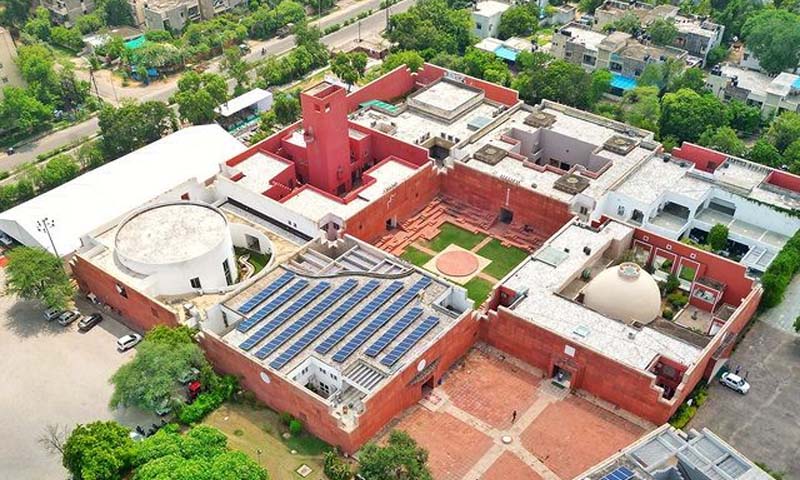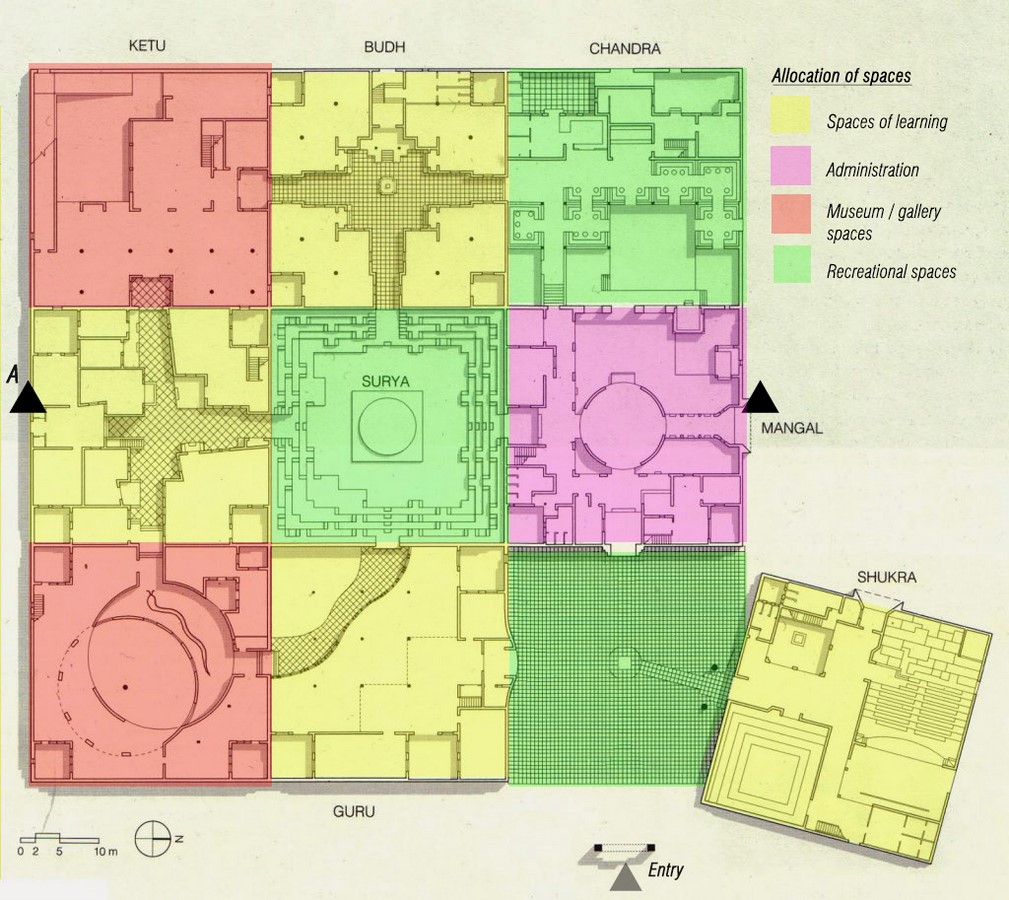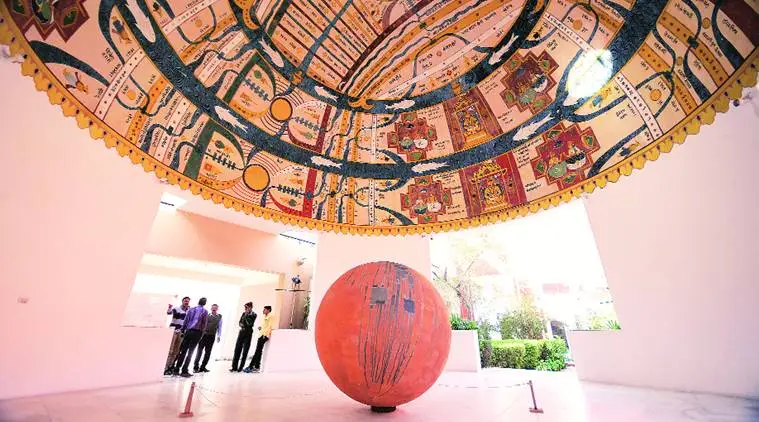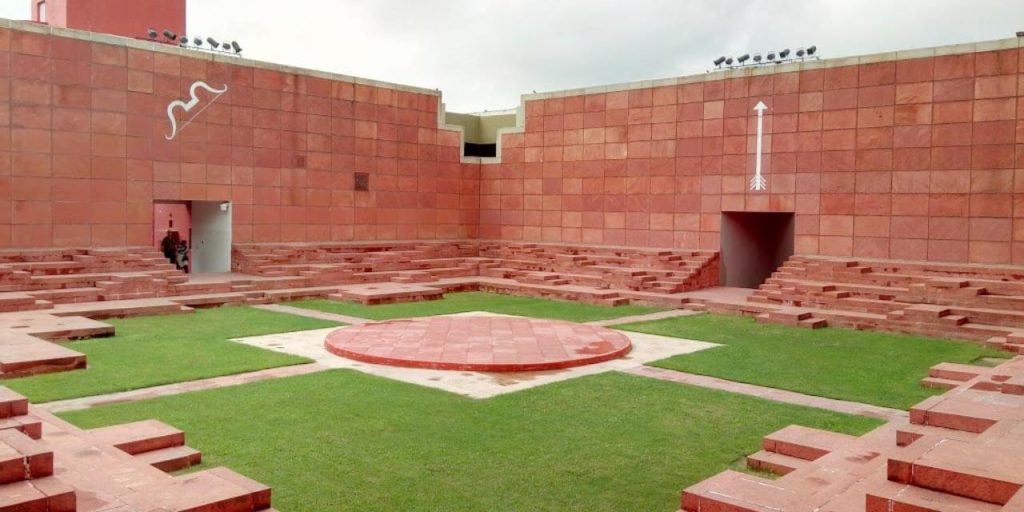It is a fact that art galleries and museums further art and artists. Had it not been for them, aeons of art, heritage, and culture would have vanished into thin air. One institution, which has done so without failing is the Jawahar Kala Kendra (JKK). It was built by the Government of Rajasthan to protect and preserve Rajasthani art and culture. If you have seen Jawahar Kala Kendra photos, we can already tell that you are obsessed with astrology-inspired architecture and glorious exhibitions. But that’s just a mere look, the multi-disciplinary art centre has so much more to offer.
Jawahar Kala Kendra Architecture
Jawahar Kala Kendra plan comprises eight blocks divided into museums, galleries, an amphitheatre, an auditorium, a library, an art studio, a small hostel, and a cafeteria. At first look, it is reminiscent of a windowless Red Fort. Designed by architect Charles Correa in 1986, it was constructed and opened to the public in 1992. Jawahar Kala Kendra plan is eerily similar to Jaipur City’s plan devised by Maharaja Jai Singh II. It consists of nine squares with the central square kept open. It is designed according to the primordial architectural principles; of the Vastu. Correa designed Jawahar Kala Kendra architecture to reflect the ‘Vastu Purush Mandala’, a nod to the model of the cosmos.

Correa’s decision to integrate the city’s ‘navagraha’ plan is imbued with local context and culture. As one enters the courtyard, they cross the verdant garden and make their way past several alfresco pavilions. Painted domes, amphitheatres, cafés, and art galleries are all accessible through archways, which appear to be encircling the building. At the theatre’s entrance is a mural depicting a palm reading, which alludes to ancient astronomy and astrology.
Astrological Squares At Jawahar Kala Kendra Jaipur
Out of the nine ‘houses,’ one is reserved for the entryway. The Jawahar Kala Kendra library is situated at the square representing ‘Brihaspati.’ At the ‘Mangala’ square one will find the administrative office. At the square dedicated to ‘Budha’ one can enjoy the museum. The museum features a grand collection of musical instruments, miniature paintings, photographs, and jewellery. At the ‘Ketu’ house, other cultural artefacts are present such as the traditional Rajasthani wooden statues, terracotta wall panels, and a heavily embellished antique carriage.

The documentation and research sectors are located at the ‘Rahu’ square, while the ‘Shukra’ square houses the theatre. Numerous art galleries including ‘Sukriti,’ ‘Parijat,’, ‘Surekh,’ and more are situated at the ‘Shani’ square. At the centre is the ‘Surya’ square, which serves as an open-air theatre, called ‘Madhyavati.’ If lost amongst the illustrious Jawahar Kala Kendra exhibitions, one can easily decipher which house they are at, thanks to the astrological symbol stamped as murals on the walls of the section.
What To Expect At Jawahar Kala Kendra
The Jawahar Kala Kendra library is home to 20,000 books on myriad subjects, including but not limited to art, architecture, culture, drama, music, and other related subjects. They continuously publish new materials on the wall paintings of Rajasthan, treasures of the Albert Hall Museum, Abhaneri, etc. along with monographs on studies of various art forms such as Ghumar, Kanhaiya, and Dhrupad. Children are regularly trained through summer schools in dance, theatre, music, painting, and other disciplines.

Apart from temporary pop-up exhibitions, Jawahar Kala Kendra also conducts an annual art-centric festival titled ‘LokRang,’ held in October. It serves as an amalgamation of the National Handicraft Fair and the National Dance Festival. Adjacent to JKK’s main building, the 9.5-acre Shilpgram rural complex serves as a venue for festivals, fairs, and haat bazaars. Braj (Bharatpur), Hadauti (Kota), Tribal (Dungarpur), Desert (Barmer and Bikaner), Shekhawati (Sikar), and Center (Jaipur) are represented by the six huts.
Image Courtesy – Jaipur Tourism
Kolkata Centre for Creativity: A Hub of Artistic Innovation and Cultural Expression






